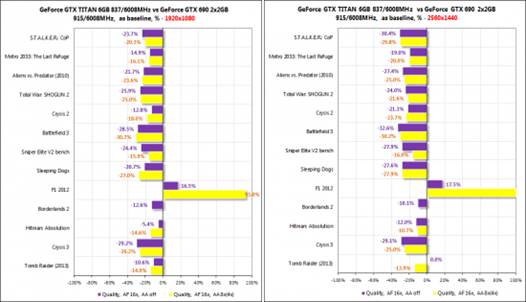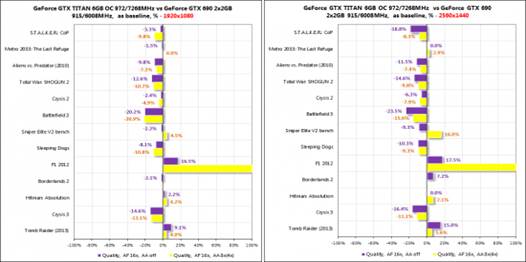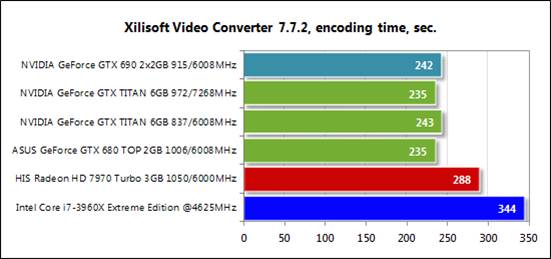Performance Summary
The chart summary is only based on the experimental
results in the games. First, let us examine the difference between the new GeForce
GTX Titan with the GeForce GTX680, and the following products based on the
baseline.

The
GeForce GTX Titan and the GeForce GTX 680
The Titan is 34-47% ahead at 1920x1080 and
39-55% at 2560x1440 resolution on average over the trials. We can see that it
has more advantages when set to the highest picture quality, especially when
turn eliminate full-screen aliasing. The 384-bit wide memory demonstrates its
value here. The Shader capacity of the processors is increased, and the texture-mapping
unit and the raster image available at the GK 110 chip also cannot be ignored.
Next we see how the GeForce GTX Titan is slower
than the GeForce GTX 690. We can remind you that both samples have similar
price proposal at $ 999.

The
GeForce GTX Titan and the GeForce GTX 690
Except for odd results in F1 2012, the Titan
always follows the GTX 690 with a similar distance in every game. It is 10-12%
slower at 1920x1080 resolution through all test games and 7-19% slower at
2560x1440 resolution. The influence of increased memory and its interface can
be easily observed here.
When overclocked GeForce GTX Titan from
837/876/6008 MHz to 973/1011/7268 MHz, the GeForce GTX 690 gap to narrow. Titan
is overclocked might even win a few tests.

The
GeForce GTX Titan and the GeForce GTX 690
The pair of the final chart summary is
unrelated to the topic of our review, however, we still want to compare the
GeForce GTX 680 with the Radeon HD 7970 GHz Edition. We compared the GTX 680
with the HD 7970 here a year ago, Nvidia was found to be the best in most
tests. However, AMD has not reduced the price of its proposal to the
accelerator because its clock from 925/5500 to 1050/6000 MHz. Several optimized
driver has been installed in the Catalyst and the GeForce, and a few new games
are also available. So, here are the results we have been in competition this
instant:

The
GeForce GTX 680 and the Radeon HD 7970 GHz Edition
As we can see, the Radeon HD 7970 GHz
Edition is on the verge of victory here, which is a bad news for Nvidia. Only
in Borderlands 2, in the regime of high-quality images of Total War: Shogun 2 -
Fall of the Samurai and F1 2012 (no MSAA features), the new GeForce GTX 680 is
the winner. Radeon has always led in every remaining game.
CUDA and OpenGL Performance
Besides the traditional game testing, we
wanted to check in GK 110 GPU compute applications and coding. First, the
process of grading system with SmoothVideo Project - SVPMark 3.0.3a (the actual
test scores received):

SmoothVideo
Project - SVPMark 3.0.3a
The GeForce GTX Titan does not show
anything special here. It is close to the GeForce GTX 680 and does not increase
its score much when overclocked.
Next we measure the speed of the encoding
process HD video in Xilisoft Video Converter version 7.7.2 supports both AMD
and Nvidia. We take a 2.5-GB Full-HD video and convert it to iPad 4. Files get
750 MB capacity. Take a little time for the chart below, it will be better:

Xilisoft
Video Converter version 7.7.2
Nvidia GPU outperforms its AMD rival and
Intel 6-core CPU of this review. The GTX 690 with dual processors does not
provide any additional benefit. Xilisoft Video Converter does not seem like
that was fun with all the ability of GK 110.
The next test is the grading system in
version 0.45b DirectCompute. We will show you the number of DirectCompute and
OpenCL points on the graph:

DirectCompute
version 0.45b
We also try to check GK 110 out more with
LuxMark but the latest version 2.0 of it is not compatible with the GeForce GTX
Titan, which stopped the process because of faults. Therefore, we can only
grade the system with older graphics cards only:

LuxMark
latest version 2.0
The GeForce GTX Titan must be as fast as
the GeForce GTX 690 but we will ensure this after LuxMark new version is
compatible with the GK 110. Thus, we can only say that the form of the Radeon
much faster here.
Conclusion
Our impression of the Nvidia GeForce GTX
Titan is somewhat unclear, and ambiguous. On the one hand, there is no doubt
that the single GPU graphics card has the fastest time in the current market.
The power consumption is not much higher than the previously leading products
from AMD and Nvidia, and it even has much less noise. It is compatible with all
the technology in the GeForce GTX 680 and provides a few other technologies
(eg, GPU Boost 2.0). And its performance is really surprising because it's more
than about 50% (or even more) than the speed of the GeForce GTX 680. We had
never seen a striking improvement with such great speed that is even on both
GPU generations. The GeForce GTX Titan demonstrates Nvidia's outstanding
technological features and it has done it in a very dramatic way to attract the
attention of people.
On the other hand, the GeForce GTX Titan is
priced at a very high level. The 10-20% slower speed than the GeForce GTX 690’s
makes it the suggested price equal and probably more expensive than the retail
one in the first two months. Moreover, users who do not care that much about
AFR rendering will probably prefer the build configuration of the Radeon HD
7970 CrossFireX GHz Edition, which is faster in many games, although it is hot
and consumes more power energy. So, the GeForce GTX Titan looks like a true
luxurious product but its price does not seem to make sense. So, if you want a
more expensive toy like that, you will feel very exciting to hear Nvidia
announces that the GeForce GTX Titan is faster than both the GeForce GTX 690
graphics cards.
The GPU Boost Technology 2.0 also raises a
few questions. The overclocking process now becomes more difficult while the
card's performance depends more on its temperature. The Titan is not original
with original cooling device which will be particularly interesting, but we do
not think that they will appear. But because there's still plenty of time for
the next generation of GPUs, Nvidia will probably be thinking of doing it to
satisfy fans of the GeForce GTX 685, and there will be 384-bit bus and 4 GB
memory because the GeForce GTX 680 is less powerful than the Radeon HD 7970 GHX
Edition with faster growth and less expensive price.
|
Nvidia GeForce
GTX Titan 6 GB’s specifications
·
Graphics processor: GK 110 “Kepler” (TSMC)
·
Production process, nm: 28 (low-k)
·
Size: mm2: 520
·
Processors: Intel ATOM dual-core Z2760 at
1.8GHz
·
GPU frequency, MHz: 3D: 837 (876-boost); 2D: 324
(876-boost)
·
Unified shader processors: 2688
·
Texturing units: 224
·
Rasterization units: 224
·
Max. theoretical fillrate, Gpixels/s: 40.2
·
Max. theoretical texture sampling rate,
Gtexels/s: 187.5
·
Pixel Shaders/ Vertex Shaders: 5.0/5.0
·
Compatible memory type: GDDR5
·
Usable video memory: 3D: 6008; 2D: 648
·
Memory size, MB: 6148
·
Memory bus width, MB: 6148
·
Memory bus bandwidth, GB/s: 288.4
·
Maximum power consumption, W 3D: 250
·
PSU requirements, W: 600
·
Reference PCB dimensions (LxWxD), mm:
267x100x39
·
Interface: PCI-Express x 16 (v3.0)
·
Output: DVI-I+DVD-D (Dual-Link), 1HDMI v1.4a,
1 DisplayPort v1.2
·
MSRP/min retail price: $999
|